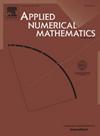椭圆膜壳模型的表面网格DG-VEM
IF 2.4
2区 数学
Q1 MATHEMATICS, APPLIED
引用次数: 0
摘要
椭圆膜壳(EMS)是一个表面上具有复杂变系数的系统,对其数值离散化提出了重大挑战。在本文中,我们利用位移分量的不同规律性,提出了一种不连续Galerkin虚元法(DG-VEM)。具体地说,我们为前两个分量构造了0连续的虚拟元素空间,而第三个分量在每个元素上使用1次多项式离散,没有强制跨元素边界的连续性。该方法提供了高度的网格灵活性,消除了显式基函数表达式的需要,并提高了精度,以实现任何期望的收敛顺序。进一步,我们建立了数值解的存在性、唯一性、稳定性和收敛性,并给出了严格的误差估计。通过数值算例验证了该算法的收敛性和稳定性。此外,我们证明了该方法对不同网格细分的适应性,并表明,对于可比的误差水平,EMS模型的DG-VEM比传统的有限元方法需要更少的自由度。本文章由计算机程序翻译,如有差异,请以英文原文为准。
A surface mesh DG-VEM for elliptic membrane shell model
Elliptic membrane shell (EMS), characterized by a system with complex variable coefficients on a surface, poses significant challenges for numerical discretization. In this paper, leveraging the differing regularity of displacement components, we propose a discontinuous Galerkin virtual element method (DG-VEM) for the EMS model. Specifically, we construct -continuous virtual element spaces for the first two components, whereas the third component is discretized on each element using a polynomial of degree l, with no continuity enforced across element boundaries. This method offers high mesh flexibility, eliminates the need for explicit basis function expressions, and improves accuracy to achieve convergence of any desired order. Furthermore, we establish the existence, uniqueness, stability, and convergence of the numerical solution, along with rigorous error estimates. Several numerical examples are presented to test the convergence and stability of the DG-VEM. Additionally, we demonstrate the method's adaptability to diverse grid subdivisions and show that, for comparable error levels, the DG-VEM for the EMS model requires significantly fewer degrees of freedom than traditional finite element methods.
求助全文
通过发布文献求助,成功后即可免费获取论文全文。
去求助
来源期刊

Applied Numerical Mathematics
数学-应用数学
CiteScore
5.60
自引率
7.10%
发文量
225
审稿时长
7.2 months
期刊介绍:
The purpose of the journal is to provide a forum for the publication of high quality research and tutorial papers in computational mathematics. In addition to the traditional issues and problems in numerical analysis, the journal also publishes papers describing relevant applications in such fields as physics, fluid dynamics, engineering and other branches of applied science with a computational mathematics component. The journal strives to be flexible in the type of papers it publishes and their format. Equally desirable are:
(i) Full papers, which should be complete and relatively self-contained original contributions with an introduction that can be understood by the broad computational mathematics community. Both rigorous and heuristic styles are acceptable. Of particular interest are papers about new areas of research, in which other than strictly mathematical arguments may be important in establishing a basis for further developments.
(ii) Tutorial review papers, covering some of the important issues in Numerical Mathematics, Scientific Computing and their Applications. The journal will occasionally publish contributions which are larger than the usual format for regular papers.
(iii) Short notes, which present specific new results and techniques in a brief communication.
 求助内容:
求助内容: 应助结果提醒方式:
应助结果提醒方式:


